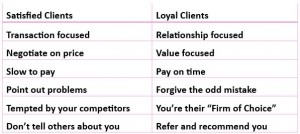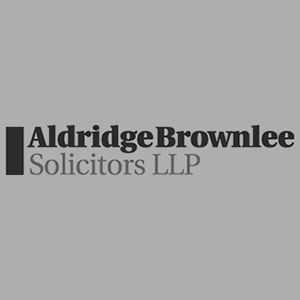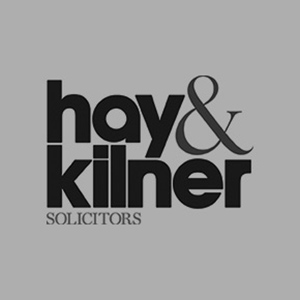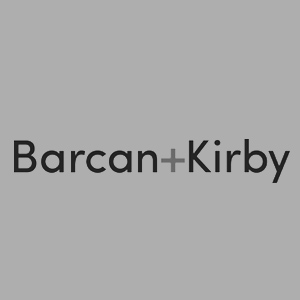Did you know that it costs 5 to 20 times as much to acquire a new client than keep an existing one? Repeat revenues, recommendations and referrals all stem from loyal customers and we’ll look at key areas including understanding the difference between satisfied and loyal clients and how to use this knowledge to increase your firm’s profitability.
Richard D Hanks of Mindshare Technologies asserts that the overriding consensus of all the research is that there is a direct link between creating loyal customers and achieving superior profits. In fact, an increase of as little as five per cent in client retention is thought to lead to as much as a 75 per cent increase in the average business’ profitability (Source: Net Promoter Score inventor Frederick Reichheld’s 2012 The Ultimate Question 2.0).
Differentiating between satisfied and loyal customers
There are key differences between these groups and only one of them will impact your bottom line. A very significant 50-70% of lost customers report being “very satisfied” or “satisfied” before defecting to another firm and Hanks’ definition of the two will allow you to consider your own client base.

How loyal clients impact your profits
A five year research project by Harvard Business School showed that firms which put their clients and staff first developed, not surprisingly, loyal clients and engaged staff. In turn, these firms increased their profits. Additionally, Reichheld clearly shows that the economic value of keeping a customer outweighs that of attracting a new one (Source: The Ultimate Question 2.0).
Even in a negative economy, 60% of consumers often or always pay more for a better experience so converting them to loyal client status is imperative because it makes good financial sense (Source: Harris Interactive, Customer Experience Impact Report) particularly when one considers the following points:
- It costs 5 to 20 times as much to acquire a new client than keep an existing one
- For every client who complains, 20 to 30 will not complain – they just won’t instruct your firm again thereby decreasing your revenue streams and forcing you to search out new business
- Each dissatisfied client will tell 8 to 10 other people (more if they take to Twitter or a review site) thereby diminishing the possibility of future business
- Providing consistently positive experiences will retain clients and improve your market position
So, the financial impact of losing customers is enormous. According to Accenture decreasing client turnover is a certain path to increased profits and, once again, the financial case is compelling:
Revenue Growth
- Loyal clients instruct you on more than one matter, trust you with different types of matter and are likely to make higher-value instructions because they perceive you to be their Firm of Choice.
- Loyal clients tend to be less price-sensitive and do not expect automatic discounts.
- Positive word-of-mouth from loyal clients increases referrals and new client acquisition.
- Improvements initiated by loyal customer feedback help to retain loyal clients, attract new ones and increase market share because you’ll be offering a service that you know people want at a price they will perceive as value for money.
Cost Reduction
- Higher client retention rates.
- Reduced costs of attracting new clients.
- Improved marketing and sales efforts at a lower cost through leveraging feedback to understand what loyal customers value most.
- Repeat clients tend to need less education on processes and often make fewer demands on a fee earner’s time, reducing costs and improving overall efficiency.
Reduce Risk and Liability
- Real-time insights can help you identify, contain and resolve problems, issues, and potential crises.
- Learning from feedback helps you transform negative client experiences into positive ones.
- By identifying and addressing problems early, you can prevent future problems and reduce liability.
If your firm has weathered this recession, the chances are that you’re doing something right but James Allen of Harvard Business School found that 80% of business may state that they offer a great customer experience, but only 8% of customers feel the same way. And these are the people that go on to do business with the original provider’s competitors.
Every firm therefore needs to understand the quality of their client experience by asking for feedback so that they can shorten the step to loyalty creation.
Increasing loyalty
There are many sources of information on this subject so this overview acts as a summary of key points rather than a master class.
- Client Expectations – understand what your clients expect from their experience and deliver it.
- Continuity – of good service provision.
- Convenience – make the transaction, from start to finish, as painless as possible. The case maybe the biggest thing in your client’s life but it doesn’t have to feel like it all of the time.
- Communication – from talking to clients within the space that they feel most comfortable (phone/email/in person) to the speed of your response to their Communications. Communicate any changes (length of matter, ongoing cost information) because people mind less if they know the full situation. And hiding behind email or voice mail is a definite no-no. Pick up the phone and talk to them!
- Competitive – it doesn’t have to be on price. Attitude and values count as does asking for a client’s future business.
- The Small Things in Life that Count - it’s easy to forget the small things that make the cogs of loyalty whir but when the Cathay Pacific Airways Flight Attendants Union suggest a “no-smile” working practice as part of their strike action for better pay conditions, it reminds us all that the small things in life count.
Client experience management
Simply put this is the practice of analysing customer feedback to measure and close the gap between the intended customer experience (what your firm thinks it’s providing) and the actual customer experience (the reality). The top three drivers for investing in customer experience management are:
- Improve customer retention – (42%)
- Improve customer satisfaction – (33%)
- Increase cross-selling and up-selling (32%)
(Source: Aberdeen report – Customer Experience Management: Engaging Loyal Customers to Evangelize Your Brand)
There are some real dividends noted as a result of good customer experience management and law firms may wish to consider that this process is most likely to:
- Strengthen your brand
- Increase revenues from current clients through cross-selling
- Increase revenues from new clients via referrals and recommendations
- Increase client loyalty through the provision of a great experience
- Lower costs by reducing client turnover
- Increase profits based on the above assumptions
Monitoring client feedback as a law firm
Developing strong relationships with clients is shown to be the key to engendering loyalty. Therefore, instead of guessing where you stand with your clients or how you need to improve your services or client experience, it makes sense to ask for feedback. What do your fee earners do really well? Which areas could you develop your staff in to ensure a better experience? Which teams typically engender referrals and recommendations from their clients? How easy are you to do business with? Would each client use you again?
Often firms overlook their most obvious source of innovative ideas and answers – their clients. Their feedback can provide clarity and perspective, enabling firms to make better decisions based on information provided by those behind the revenue streams.
This list of why feedback could help move the strategic direction of a firm and improve profits is inexhaustible. But here are a few pointers:
- Seeking feedback shows your clients that you want to improve what you offer and/or add value to their experience. It’s to everyone’s benefit.
- By reacting to your clients’ needs and wants you set your firm apart because you’ll be offering the services and process experience that they’re already telling you they will pay for.
- Evidencing the quality of your service and using it in marketing communications reinforces to current clients why you should be their Firm of Choice.
- Identifying where improvements can be made and reacting accordingly will increase satisfaction and underpin loyalty.
- Ascertaining how satisfied, loyal and committed your clients really are allows you to forecast revenues using evidence not assumptions.
- Tracking fee earners’ performance to fine tune training and development plans promotes staff engagement and better client care to ensure loyalty.
- Communicating feedback to staff empowers them to provide an improved and positive experience for clients which engenders loyalty.
Turn the negative into a positive – every time
Some feedback may be rude, unconstructive and even unwarranted but, in most feedback, you can find a nugget of gold: honest comments or a suggestion for improvement.
Put succinctly by Robin Evans, Business Development Manager of 15 partner law firm Clarkson Wright & Jakes, “It’s someone saying ‘I like you but you have not fulfilled my expectations this time and I want to tell you why’. It’s a good thing. Don’t be afraid of bad reviews – it’s a cry for help.”
And it’s worth remembering that feedback doesn’t have to be a one way diatribe. According to PR professional Katherine Evans “When a customer comes to you with a complaint or problem, it’s a perfect opportunity to demonstrate flexibility or a willingness to work to a satisfactory solution. You’re also likely to find a customer who has had a complaint resolved becomes even more loyal as a result. The short answer – customers like to be listened to, respected and valued. Going out of your way to resolve a problem, even if it’s at your own cost, demonstrates this.”
Conclusion
There is clear evidence that analysing each client’s experience of a firm and understanding how that particular experience could be improved upon is likely to ensure future loyalty which, in turn, is likely to reduce a firm’s costs whilst increasing revenues. A fundamental part of the experience review is feedback gathering. This information ensures that trends or issues (good and bad) are identified quickly and either built upon or dealt with accordingly.
The move towards requesting feedback from clients and then using that information as part of a firm’s business strategy needs to have a top-down approach. From the SMT to front of house, staff need to see the firm’s senior figure(s) advocating a culture that wants to listen to and learn from clients. Leading by example is more than a phrase – it changes behaviours and reinforces visions and values.
Understanding the differences between satisfied and loyal clients is crucial to a firm’s retention strategy and, based on economics alone, is a great starting point for firms who wish to segment and then target specific client groups. The driver for this is not just about more effective relationship building but the economic argument that an increase of as little as five per cent in client retention is thought to lead to as much as a 75 per cent increase in the average business’ profitability. Additionally, the low to minimal cost of generating new business via referrals and recommendations is an ideal way to increase revenues streams. Surely increased profits through providing the best possible client experience is the ultimate win-win situation?
Apart from the ability to increase revenues, decrease costs and produce effective working practices which deliver clients the services that they want and will view as good value, what other reasons are there to gather feedback? It comes back to continuing the client experience. By giving you feedback, your clients are telling you that they are investing their time in you as well as their money. Whether you act on their views will tell them how much you value their time, their money and, of course, their loyalty.
At Law League, we help firms to gather and analyse client feedback, producing realtime, useable management information as reports. Firms are able to focus on the feedback analysis, anonymously benchmark themselves against their peers, understand how they can increase loyalty and increase profits as a result.










Comments